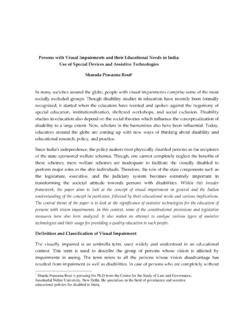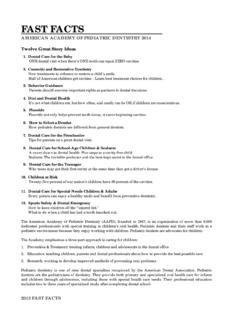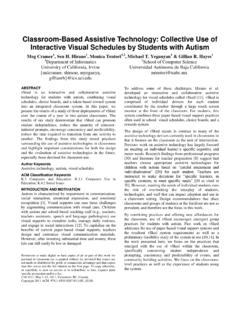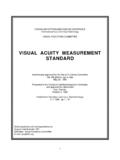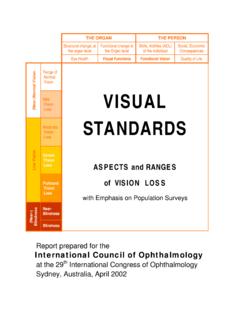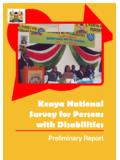Transcription of Quantitative Article Critique: Factors Affecting the ...
1 1 Quantitative Article Critique: Factors Affecting the Successful Employment of Transition-Age Youths with visual Impairments Introduction This Article examined some of the issues that affect youths with visual impairments as they transition from high school or college to employment. The researchers first mentioned that the transition from school to employment is a topic that is often discussed, but little research has been done to identify the variables that impact the transition process for youths with visual impairments (Capella-McDonnall & Crudden, 2009, p. 329). The rationale and the purpose of the study were never clearly stated. Perhaps the lack of research could be considered the rationale, but it would have been helpful to have more information justifying this study. Also concerning was that statement of the problem was never clearly written.
2 In order to identify the problem, the authors should have cited information that emphasized the high rate of unemployment for youths with visual impairments. A study by Nagle (2001) is an excellent example of citing unemployment rates for youths with visual impairments. That information could have nicely transitioned into a purpose statement for this study. Review of the Literature Following the introduction, the researchers used the review of the literature to define the variables as well as explain how those variables have been previously studied. That helped me gather a better understanding of the amount of research that had been done on each variable. I also gained an idea of the direction of the study and what the authors wanted to analyze. This was especially helpful since the introduction did not state the purpose of the study.
3 2 To organize a framework, the authors discussed the relevance of work experience, self-determination, locus of control, academic competence, self-esteem, and the role of assistive technology (Capella-McDonnall & Crudden, 2009, pp. 329-331). All of these topics were defined, although they were not labeled as variables until later. Information from previous research was cited to show correlations between each variable and finding employment. I noticed, however, that the authors cited research that studied youths with disabilities, secondary school students, and university graduates, but I wondered if more research that related specifically to students with visual impairments could have been cited. I also wondered how the authors selected their variables. Were the variables simply topics that interested the authors or did those variables repeatedly show up in other studies as the most significant variables that related to employment?
4 The answer was never clarified. Following these questions, I looked for counterarguments that might help one better comprehend the overall circumstances for youths with visual impairments that seek employment. I did not see any counterarguments or contradicting research. This information would have helped me better understand why the authors chose to take a closer look at certain variables. Contradicting research could have also served as a rationale for performing this study. Looking over the constructs of the study, the review of the literature defined the variables that the researchers wished to evaluate, but the definition of the dependent variable (employment) was vague (Capella-McDonnall & Crudden, 2009, p. 332). Did employment mean full-time, part-time, or both? Was it long-term or temporary?
5 What about minimum wages? To me, the definition of employment imposed a threat to construct validity because such a broad definition could have allowed variables to be overlooked. That in turn could have produced misleading results. 3 Upon examining the sources cited in the review of the literature, I noticed that the National Longitudinal Transition Studies of Special Education Students (NLTS1 and NLTS2) were not mentioned. Although NLTS2 was referenced in the discussion section of this Article , I expected to see it cited sooner. One study that could have been helpful to reference was conducted by Kirchner and Smith (2005). In that study, the researchers reported the wages generally earned by youths with visual impairments versus youths with other disabilities. That information could have been used to improve the definition of employment.
6 Otherwise, I recognized a lot of the names that the researchers cited. Methodology At the end of the review of the literature, the researchers created hypotheses and research questions. The hypotheses were as follows (Capella-McDonnall & Crudden, 2009, p. 331): 1. Early work experiences will be associated with employment. 2. Academic competence will be associated with employment. 3. Self-determination skills will be associated with employment. 4. Higher levels of self-esteem will be associated with employment. The research questions were as follows (Capella-McDonnall & Crudden, 2009, p. 331): 1. Is the use of assistive technology or devices associated with employment? 2. Is involvement with the counselor in the vocational rehabilitation process associated with employment? 3. Is an internal locus of control associated with employment?
7 Following the hypotheses and the research questions, the researchers listed the variables. The dependent variable was employment and the independent variables were work experience, self-determination, academic competence, self-esteem, locus of control, level of involvement with a counselor, and the use of assistive technology (Capella-McDonnall & Crudden, 2009, p. 332). The authors explained how each independent variable would be measured and made some limitations to control them (Capella-McDonnall & Crudden, 2009, p. 333). After describing the 4 dependent and independent variables, the researchers did not identify any intervening or confounding variables. To reduce the threats to internal validity, the researchers should have listed some intervening variables, such as the amount of time worked at a specific job, rather than simply determining when the most recent job was held.
8 Other intervening variables might have been job shadowing experience, volunteer experience, membership in community organizations, and access to print materials, as mentioned in a study by Nagle (2001). Besides the intervening variables, I believe that some confounding variables should have been listed. One example might be existing social networks of families and friends. Youths that have large social networks may have more success with finding employment than youths with small social networks, regardless of any of the independent variables. Additional confounding variables might be biases in society toward people with disabilities, one s work ethic, punctuality, employer reviews, previous job duties, and social interaction skills. Nagle (2001) especially stressed the influence of social interaction skills, even though they are difficult to measure.
9 Such information would have been beneficial as part of this research. For this study, the population of interest was transition-age youths with visual impairments (Capella-McDonnall & Crudden, 2009, p. 332). The data was taken from Cornell University s website for the Longitudinal Study of the Vocational Rehabilitation Services Program, or LSVRSP (Capella-McDonnall & Crudden, 2009, p. 331). That study used a multi-state, complex design to select its sample. To obtain the sample for this study, the researchers set certain criteria and selected the sample from LSVRSP data. I did not see any information regarding ethical considerations of human subjects or an IRB process. I assumed that this information might have been included in the LSVRSP report, since that contained public use data. This study s sample included youths under age 21 (at the time they applied for vocational 5 rehabilitation) who had visual impairments listed as a primary or secondary disability.
10 The final sample consisted of 41 youths, which is rather small. It would have been helpful to understand the sampling procedure since the initial data set consisted of over 8,500 people (Capella-McDonnall & Crudden, 2009, p. 331). The reader is left wondering how such a small sample size was generated. Without any explanation, one might assume that the majority of the subjects had other disabilities or were above age 21. Due to the small sample size, the researchers used univariate analyses for most of the variables. These included t-tests, Fisher s exact test, and logistic regression. For the locus of control measure, the researchers used the multivariate analysis of variance procedure (Capella-McDonnall & Crudden, 2009, p. 333). To reduce the likelihood of a Type I error, the researchers used a method developed by Benjamini and Hochberg (1995).
